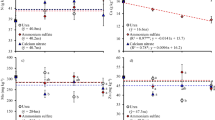Summary
-
[1]
Losses of ammonia from application of anhydrous ammonia were negligible when applied at a rate of 100 pounds N per acre and injected 4 inches or more below the surface.
-
[2]
Anhydrous ammonia was not as effective as ammonium nitrate as a source of nitrogen for rye cover crop. This was probably due to the fact that it was rapidly fixed in a relatively small area around the injection band.
-
[3]
There was no indication of differences between the two sources in leaching or other loss of nitrogen occurring from fall application.
-
[4]
Neither fertility treatments or the different amounts of organic matter plowed under had any effect on potato yields. The latter was not unexpected over an interval as short as three years. Similarly, no differences in nutrient levels of the soil, as determined by complete soil test, development during the course of this experiment.
-
[5]
Data from three years’ experimentation plus observations on methods, cost, and ease of application, strongly indicate that ammonium nitrate is superior to anhydrous ammonia as a source of nitrogen for rye cover crops in this area.
Similar content being viewed by others
Literature Cited
Anderson, O. E. and E. R. Purvis. 1953. Anhydrous ammonia increases crop yields. N. J. Agr. Sept.–Oct.
Andrews, W. B. 1956. Anhydrous ammonia as a nitrogenous fertilizer. Advanc. Agron. 8: 61–125.
Barr, H. T. 1952. Anhydrous ammonia equipment. Louisiana Agr. Expt. Sta. Bull. 462.
Blue, W. G. and C. F. Eno. 1954. Distribution and retention of anhydrous ammonia in sandy soils. Soil Sci. Soc. Am. Proc. 18: 420–424.
Blue, W. G. and C. F. Eno. 1957. The effect of lime on plant growth and recovery of nitrogen from anhydrous ammonia, urea and ammonium nitrate in acid sandy soils. Soil Crop Sci. Soc., Florida Proc. 17: 255–261.
Campbell, J. A. 1950. Anhydrous ammonia as source of nitrogen for cabbage, tomatoes and beans. Proc. Am. Soc. Hort. Sci. 56: 253–256.
Cowett, E. R. and H. J. Murphy. 1958. Anhydrous ammonia and nitrogen solutions for Maine crops. Maine Farm Res. 6(2): 33–35.
Eck, H. V. et al. 1957. Anhydrous ammonia and ammonium nitrate fertilizers for wheat. Oklahoma Agr. Expt. Sta. Bull. B493: 1–15.
Gull, P. W. 1950. Advantages, limitations and present status in the use of liquid and gaseous fertilizers. Proc. Nat. Joint Comm. Fert. Appl. 26: 72–77.
Hammons, J. G. 1948. Efficiency of anhydrous ammonia as a source of nitrogen on fall planted oats for forage and grain production. Soil Sci. Soc. Am. Proc. 12: 266–269.
Hawkins, A. and B. A. Brown. 1953. Rate, placement and source of nitrogen for potatoes in Connecticut. Conn. Agr. Expt. Sta. Bull. 298.
Hawkins, Arthur. 1956. Response of potatoes to fertilizer nitrogen in the Northeast. Am. Potoato J. 33: 226–233.
Lorenz, O. A., J. C. Bishop and D. N. Wright. 1955. A comparison of the fertilizer value of gaseous, liquid and solid forms of ammonia — containing nitrogen compounds. Proc. Mtg. Nat. Comm. Fert. Appl. 31: 17–36.
Martin, J. P. and Chapman, H. O. 1951. Volatilization of ammonia from sulfur-fertilized soils. Soil Sci. 61: 25.
Murphy, H. J. 1957. Anhydrous ammonia shows up well on processing crops. Maine Farm Res. 5: (1) 31–32.
Pearson, R. W. et al. 1961. Residual effects of fall and spring applied nitrogen fertilizers on crop yields in the Southeastern United States. U.S. Dept. Agr. Tech. Bull. 1254.
Sawyer, R. L. and S. L. Dallyn. 1958. Nitrogen fertilization of potatoes. Am. Potato J. 35: 645–650.
Smith, J. B., M. Salomon and R. M. Beverage. 1952. Nitrogen fertilizers for rye cover crops. Univ. Rhode Island Expt. Sta. Bull. 314.
Sohn, J. B. and M. Peech. 1958. Retention and fixation of ammonia by soils. Soil Sci. 85: 1–9.
Struchtemeyer, R. A. and C. E. Cunningham. 1956. Anhydrous ammonia will produce potatoes. Maine Farm Res. 4: (2) 21–23.
Terman, G. L., A. Hawkins, C. E. Cunningham, and R. S. Struchtemeyer. 1951. Rate, placement and source of nitrogen for potatoes in Maine. Maine Agr. Expt. Sta. Bull. 506.
Author information
Authors and Affiliations
Additional information
Paper No. 514, Dept. of Vegetable Crops, Cornell University, Ithaca, N. Y.
Rights and permissions
About this article
Cite this article
Dallyn, S.L., Sawyer, R.L. Anhydrous ammonia vs. ammonium nitrate as sources of nitrogen for rye cover crops on the potato soils of long Island1. American Potato Journal 41, 201–207 (1964). https://doi.org/10.1007/BF02855084
Accepted:
Issue Date:
DOI: https://doi.org/10.1007/BF02855084



